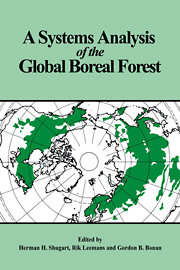Book contents
- Frontmatter
- Contents
- List of contributors
- 1 Introduction
- Part 1 Processes in boreal forests
- Part 2 Patterns in space and time in boreal forests
- Introduction
- 7 The transition between boreal forest and tundra
- 8 The southern boreal–northern hardwood forest border
- 9 Transitions between boreal forest and wetland
- 10 Remote sensing technology for forest ecosystem analysis
- 11 The nature and distribution of past, present and future boreal forests: lessons for a research and modeling agenda
- Part 3 Computer models for synthesis of pattern and process in the boreal forest
- References
- Index
10 - Remote sensing technology for forest ecosystem analysis
Published online by Cambridge University Press: 12 January 2010
- Frontmatter
- Contents
- List of contributors
- 1 Introduction
- Part 1 Processes in boreal forests
- Part 2 Patterns in space and time in boreal forests
- Introduction
- 7 The transition between boreal forest and tundra
- 8 The southern boreal–northern hardwood forest border
- 9 Transitions between boreal forest and wetland
- 10 Remote sensing technology for forest ecosystem analysis
- 11 The nature and distribution of past, present and future boreal forests: lessons for a research and modeling agenda
- Part 3 Computer models for synthesis of pattern and process in the boreal forest
- References
- Index
Summary
Introduction
Investigators worldwide are fundamentally concerned about vegetation changes within forest ecosystems across spatial and temporal scales. The nature and extent of the impacts of these changes, as well as the feedbacks to global climate, are being addressed through modeling the interactions of the vegetation, soil, and energy components of the forest ecosystem. Mathematical models of the dynamics of forest succession and soil processes, combined with observations of forest ecosystems, can provide much of the insight required to comprehend these processes and construct initial cause-and-effect relations. In practice, model testing is complicated by the difficulties of making necessary observations at the required scales. Observations of ecological factors, such as the successional stage of landscape units, at regional scales and over periods of decades or longer are particularly difficult. To effectively utilize the modeling strategies described elsewhere in this book, large amounts of information are required concerning the scope and state of boreal forest ecosystems. Remote sensing technology provides the only feasible means of acquiring this information, repeatedly, with a synoptic view of the landscape. In addition, the incorporation of remotely sensed data into models of forest ecosystem dynamics can be used to characterize northern–boreal forest ecosystems, especially with regard to the interpretation of landscape patterns and processes at local and regional scales.
The launch, by the National Aeronautics and Space Administration (NASA), of the Landsat multi-spectral scanner (MSS) in 1972 ushered in a new era for terrestrial ecologists by providing a synoptic view of the global landscape over an extended period of time.
- Type
- Chapter
- Information
- A Systems Analysis of the Global Boreal Forest , pp. 267 - 290Publisher: Cambridge University PressPrint publication year: 1992
- 1
- Cited by



